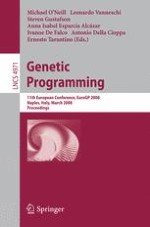The 11th European Conference on Genetic Programming, EuroGP 2008, took place in Naples, Italy from 26 to 28 March in the University of Naples Congress Centre with spectacular views over the Gulf of Naples. This volume contains the papers for the 21 oral presentations and 10 posters that were presented during this time. A diverse array of topics were covered re?ecting the current state of research in the ?eld of Genetic Programming, including the latest work on representations, theory, operators and analysis, evolvable hardware, agents and numerous applications. A rigorous, double-blind peer review process was employed, with each s- mission reviewed by at least three members of the international Program C- mittee. In total 61 papers were submitted this year, making an acceptance rate of 34% for full papers, and an overall acceptance rate of 51% including posters. S- mission of papers and the reviewing process were greatly assisted by the use of the MyReview management software originally developed by Philippe Rigaux, Bertrand Chardon and other colleagues from the Universit´e Paris-Sud Orsay, France. We are especially grateful to Marc Schoenauer from INRIA, France for managing this system. Reviewers were asked to nominate keywords specifying their area of expertise, and these keywords were matched to those selected by the authors of the submitted papers with the assistance of the optimal assignment feature of the conference management software.
